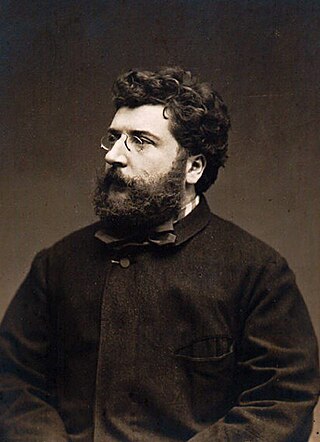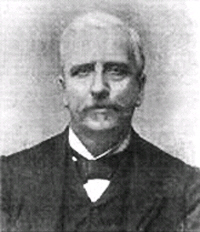
Georges Bizet was a French composer of the Romantic era. Best known for his operas in a career cut short by his early death, Bizet achieved few successes before his final work, Carmen, which has become one of the most popular and frequently performed works in the entire opera repertoire.

La source is a ballet in three acts/four scenes with a score composed by Léo Delibes and Ludwig Minkus which was premiered in Paris in 1866 with choreography by Arthur Saint-Léon. In 1878 in Vienna it was called Naïla, die Quellenfee.

Henri-Gustave Casadesus was a violist, viola d'amore player, composer, and music publisher.

Paul Henri Büsser was a French classical composer, organist, conductor and teacher. Among his teachers were César Franck, Charles Gounod and Jules Massenet. In addition to his own compositions Büsser edited and orchestrated a wide range of music – mostly but not exclusively French – dating from the 17th to the 20th centuries. He was at various times in his career the conductor of the Paris Opéra and the Opéra-Comique, and professor of composition at the Conservatoire de Paris.

L'Arlésienne is incidental music composed by Georges Bizet for Alphonse Daudet's drama of the same name, usually translated as The Girl from Arles. It was first performed on 30 September 1872 at the Théâtre du Vaudeville in Paris. Bizet's original incidental music consists of 27 numbers for chorus and small orchestra, ranging from pieces of background music (mélodrames) only a few measures long, to entr'actes. The score achieves powerful dramatic ends with the most economic of means. Still, the work received poor reviews in the wake of the unsuccessful premiere and is not often performed now in its original form, although recordings are available. However, key pieces of the incidental music, most often heard in the form of two suites for full orchestra, have become some of Bizet's most popular compositions.
Arseny Nikolayevich Koreshchenko was a pianist and composer of classical music, including operas and ballets. He was from the Russian Empire.
Hershy Kay was an American composer, arranger, and orchestrator. He is most noteworthy for the orchestrations of several Broadway shows, and for the ballets he arranged for George Balanchine's New York City Ballet.
Désiré Louis Corneille Dondeyne was a French conductor, composer and teacher who was born in Laon in the Aisne département.

The Dolly Suite, Op. 56, is a collection of pieces for piano duet by Gabriel Fauré. It consists of six short pieces written or revised between 1893 and 1896, to mark the birthdays and other events in the life of the daughter of the composer's mistress, Emma Bardac.

Théodore-César Salomé was a French organist and composer.

Alexandre Levy was a Brazilian composer, pianist and conductor. Born in São Paulo, he pioneered a fusion of classical composition with Brazil's popular folk music and rhythms. Levy died prematurely at the age of 27, and is the first known musician to die at the infamous 27 Club age. His hometown grants a prestigious award in his name.

Richard Roy Douglas was an English composer, pianist and arranger. He worked as musical assistant to Ralph Vaughan Williams, William Walton, and Richard Addinsell, made well-known orchestrations of works such as Les Sylphides and Addinsell's Warsaw Concerto, and wrote a quantity of original music.

Sergei Vladimirovich Yuferov was a Russian (Ukrainian) composer and pianist.

Désiré Magnus was a Belgian concert pianist, teacher and composer of salon music who published under the pseudonym D. Magnus.

The Carmen Suites are two suites of orchestral music drawn from the music of Georges Bizet's 1875 opera Carmen and compiled posthumously by his friend Ernest Guiraud. They adhere very closely to Bizet's orchestration. However the order of the musical allusions are in reversed chronological order, and do not adhere to the operatic versions entirely, although the Suite is directly inspired by Bizet's opera.

Paul Lacombe was a Languedocien (French) composer and pianist.
Le Petit Elfe Ferme-l'œil is an orchestral suite by Florent Schmitt adapted from his music for the homonymous ballet after a tale by Hans Christian Andersen. The concert suite developed from a piano four hands suite written in 1912 entitled une semaine de Petit Elfe ferme-l'œil was premiered on 1 December 1923 at the Concerts Colonne under the direction of Gabriel Pierné. The ballet was premiered on 5 February 1924 at the Opéra-Comique of Paris under the direction of Albert Wolff.
Marc Burty was a French composer and music teacher for Lycée de Lyon who also went by the pseudonym, Georges Bull, in some of his works. He became interested in the harmonium after building a relationship with Alfred Lefébure-Wély in Paris who introduced him to the instruments, in which Burty later taught the instrument in the Lyon-based institution. He mainly wrote music pieces for the piano and were published in Paris between 1859 and 1900.

















